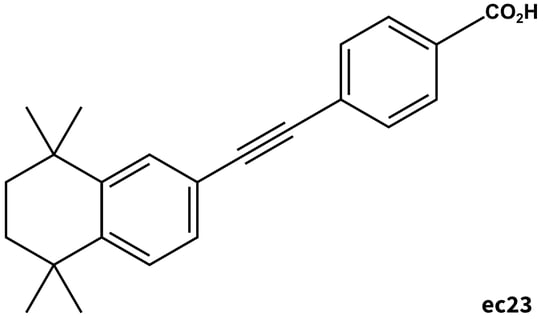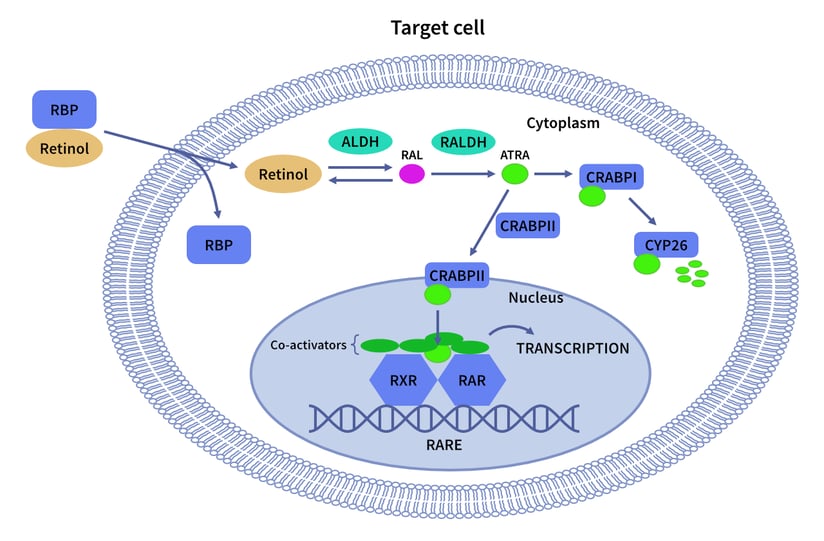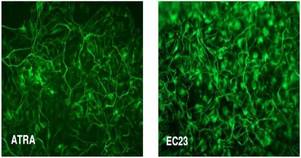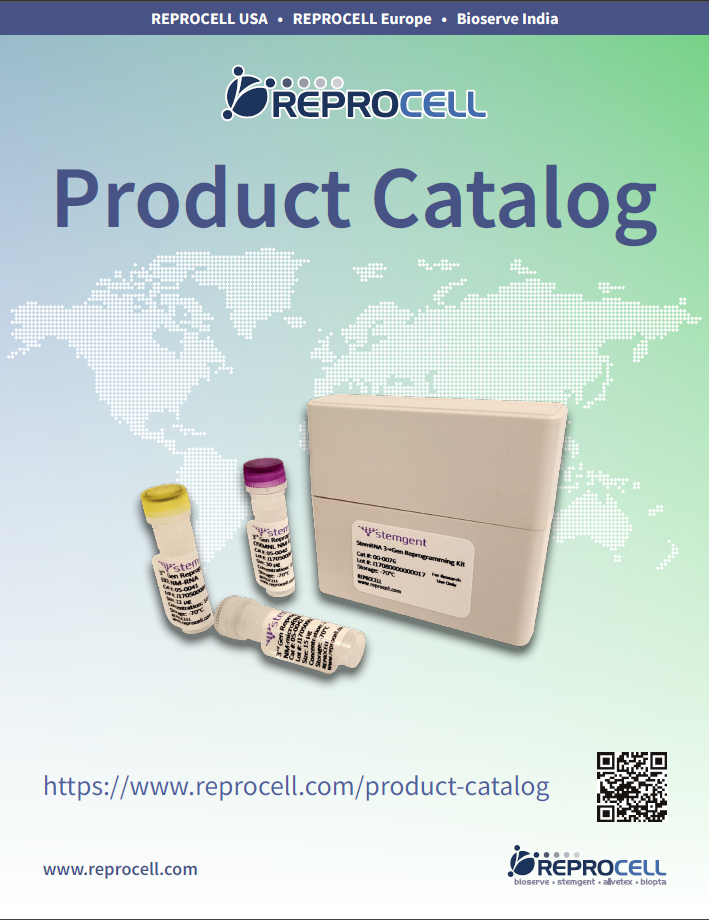ec23 is a stable synthetic retinoid, developed by collaborative work of REPROCELL’s CSO Prof. Stefan Przyborsk, used as an alternative to all-trans-retinoic acid (ATRA). ATRA, also known as tretinoin, is widely used to direct the differentiation of cultured pluripotent stem cells.

What is ATRA?
ATRA is a vital metabolite derived from vitamin A. It orchestrates growth and developmental functions associated with vitamin A, primarily by inducing gene transcription through its interactions with Retinoic Acid Receptors (RARs). These are ligand-dependent transcriptional regulators. ATRA and other retinoids have multiple applications. They were initially recognised for their role in cellular differentiation during embryogenesis and more recently in the treatment of acute promyelocytic leukemia (APL) and various skin conditions.(1)(2)
In the realm of stem cell in vitro research, ATRA assumes a pivotal role in the early stages of cellular differentiation. This occurs through a mechanism where ATRA binds to RAR receptors, forming heterodimer complexes with Retinoid X Receptors (RXRs). These complexes then bind to Retinoic Acid Response Elements (RAREs) within the nucleus. The binding of Retinoic Acid (RA) triggers a cascade of events:
-
It instigates alterations in the interactions between RAR/RXRs and co-repressor and co-activator proteins, thereby activating the transcription of primary target genes.
-
It modifies interactions with proteins that induce epigenetic changes, contributing to the broader landscape of cellular differentiation.
-
RA induction leads to the transcription of genes encoding transcription factors and signalling proteins. This results in a complex network of gene expression modifications, further refining the process of cellular differentiation. (3)

Figure 1- Mechanism of action for RXR/RAR transcription
Could ATRA be limiting your research?
The instability of ATRA is well documented, with its sensitivity to the environment. Retinoids such as ATRA are excellent chromophores, they efficiently absorb light and readily isomerise to a mixture of ATRA, 9-cis-retinoic acid (9CRA), 13-cis-retinoic acid (13CRA) and other species. This is not a desirable property for cell culture reagents, where consistency and reliability of a molecule is important for robust, reproducible results.
REPROCELL has addressed this issue by developing a synthetic retinoid analogue molecule called ec23, which effectively mimics ATRA to induce pluripotent stem cell differentiation. To assess the structural stability of ec23 and ATRA, both compounds were subjected to prolonged exposure to light and analyzed using nuclear magnetic resonance (NMR) spectroscopy. The results revealed significant isomerization and degradation in ATRA, while ec23 remained fully intact.
REPROCELL Stemolecule™ ec23 is a pan-RAR receptor agonist that is stable and maintains the same biological activity as ATRA (all trans retinoic acid). ATRA is well known for its ability to regulate cell differentiation.
When human TERA2.cl.SP12 pluripotent stem cells were exposed to either 10 mM ec23 or ATRA, both substances led to the formation of populations of terminally differentiated neurons. Immunocytochemical staining for neurofilament-200 was conducted on the differentiated cultures, and the quantification of positive cells demonstrated that ec23 is a more potent inducer of neurogenesis compared to ATRA. In a direct comparison with ATRA, synthetic retinoid ec23 not only induces larger numbers of neural cells but also exhibits less variability, offering the additional advantage of compound stability.

Compound Photostability
In order to study the relative stability of ec23 against ATRA, solutions of each were exposed to different environmental conditions and then studied by NMR spectroscopy. Example data shows that ATRA is reasonably stable over a period of three days when kept in the absence of light, exposed to air, and dissolved in DMSO. However, exposure to fluorescent light causes >63% isomerisation and degradation. In comparison, ec23 is completely stable under the same conditions. (4)

Exploring ec23 potential in skin physiology
Retinoids such as ec23 play a crucial role in regulating epidermal cells, influencing processes such as proliferation and differentiation in cultured keratinocytes. These compounds inhibit both early and late stages of keratinocyte differentiation while promoting a proliferative phenotype. In vivo studies on human and mouse skin show that retinoid treatment increases basal keratinocyte proliferation, resulting in thicker suprabasal strata with potent and chronic treatments associated with reduced terminal differentiation and impaired skin barrier function (5).
Due to their impact on various aspects of skin homeostasis, including keratinocyte function, skin surface lipids, sebum production and extracellular matrix deposition, retinoids are commonly used in skin therapeutics and cosmetics. They have been employed to treat conditions such as psoriasis, acne and neoplasms, and are frequently included in anti-aging preparations (5).
The widespread use of natural retinoids is, however, hindered by their innate toxicity and the development of resistance, where the beneficial effects of all-trans retinoic acid (ATRA) are quickly diminished by metabolic breakdown. To address these issues, synthetic retinoids, such as ec23, have been developed. ec23 is a stable analogue with enhanced photostability, resisting conditions that affect ATRA. It acts as a potent agonist of retinoic acid receptors (RARs), particularly RARβ and RARγ, and activates RARα at nanomolar concentrations. Pluripotent stem cell studies have shown that ec23 induces neuronal differentiation similarly to ATRA. The enhanced stability and potency of ec23 make it a promising candidate for further evaluation in epidermal proliferation and differentiation studies. (5)
References
- Schenk T, Stengel S, Zelent A. Unlocking the potential of retinoic acid in anticancer therapy. Br J Cancer. 2014;111(11):2039-2045.
3. Christie VB, Barnard JH, Batsanov AS, et al. Synthesis and evaluation of synthetic retinoid derivatives as inducers of stem cell differentiation. Org Biomol Chem. 2008;6(19):3497-3507.
4.Liang C, Qiao G, Liu Y, et al. Overview of all-trans-retinoic acid (ATRA) and its analogues: Structures, activities, and mechanisms in acute promyelocytic leukaemia. Eur J Med Chem. 2021;220:113451.
5.Määttä A, Nixon R, Robinson N, et al. Regulation of epidermal proliferation and hair follicle cycling by synthetic photostable retinoid EC23. J Cosmet Dermatol. 2023;22(5):1658-1669.






